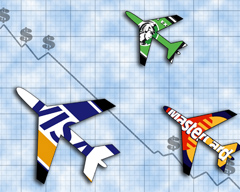
Rewards programs can often be misleading to consumers
NEW YORK
– Credit cards that offer rewards are increasingly popular, from
gas company cards that give cash back to airline cards that award
free tickets and retail cards that provide discounts on
clothes.
Rewards programs can often be misleading to consumers
NEW YORK – Credit cards that offer rewards are increasingly popular, from gas company cards that give cash back to airline cards that award free tickets and retail cards that provide discounts on clothes.
But as they proliferate, so do the possible problems. The cards often carry hefty annual fees and complicated rules that make it hard for consumers to claim their bonuses. And there’s nothing that prevents card issuers or loyalty program sponsors from changing the rules at any time to make it harder for participants to claim a prize.
“You really have to look at whether the reward is something you want and worth what you’re investing,” said Robert McKinley, chief executive of CardTrak.com, an online publisher of information about payment cards.
For starters, most rewards cards have an annual fee – and the better the rewards, the higher the fee, McKinley said.
In addition, rewards cards often carry a higher interest rate than regular cards. For the six out of 10 Americans who carry balances month-to-month, that can mean higher finance charges, he said.
“If you carry a balance, the bottom line for you is the interest rate,” McKinley said. “You don’t want to be paying a lot in interest and getting just a little back if you can get a more competitively priced card.”
Consumers also need to know that if they’re late paying their credit card bill or go over the limit, their rewards could be frozen or canceled.
Still, people who like the idea of getting rewards – especially for purchases they’d probably be making anyway – can search for the type of rewards program they want at McKinley’s site www.cardtrak.com or at others, including www.bankrate.com and www.creditcards.com. Many of the sites segment their offerings by the type of reward – points, retail, gas, travel, auto or home improvement.
Mark Shipley, global practice leader of loyalty solutions for MasterCard Advisors, a consulting arm of the credit card company, said the latest trend was for merchants to create their own rewards cards. He noted, for example, that the Saks Fifth Avenue World Elite MasterCard allows customers to earn points toward Saks’ gift cards with purchases in Saks store and elsewhere.
Another trend, especially with high-end cards, is offering consumers the opportunity to choose their own rewards, as in “go out and buy something and we’ll cover the cost with your points.”
Shipley advises consumers to look for rewards cards that address their personal goals.
“Are you interested in travel? Things like TVs? Saving money?” he asked. “Cards are geared to specific segments like these.”
Another thing to consider is what he termed “the individual value proposition” that each card offers. That is, how many points do you get for each dollar you spend? How many different places can you earn those points? How easy is it to collect the rewards?
Shipley said that terms have become more consumer friendly. For example, “we don’t see point expiration so much anymore,” he said. And, he said, many companies have improved the process for redeeming rewards earnings.
“After all,” he said, “loyalty programs are designed to retain customers.”
Still, consumers need to read the fine print on card applications so they know the limits on reward offerings, said a newly released credit card study by Consumer Action, a San Francisco-based consumer watchdog.
The study found, for example, that with the American Express Blue Cash card, a consumer doesn’t get 5 percent cash back until his or her purchases reach $6,500 in a given year; before that, the reward is 0.5 percent to 1 percent. With Discover Card’s gas card, a consumer gets 5 percent on gas, vehicle or mechanical purchases, but just 1 percent on non-auto purchases, it said.
Another limitation: “Most rewards cards stipulate that your ‘everyday’ purchases are at places like grocery stores and drug stores, not discount or department stores.” That means consumers sometimes may want to forgo rewards accumulation in favor of lower prices.









